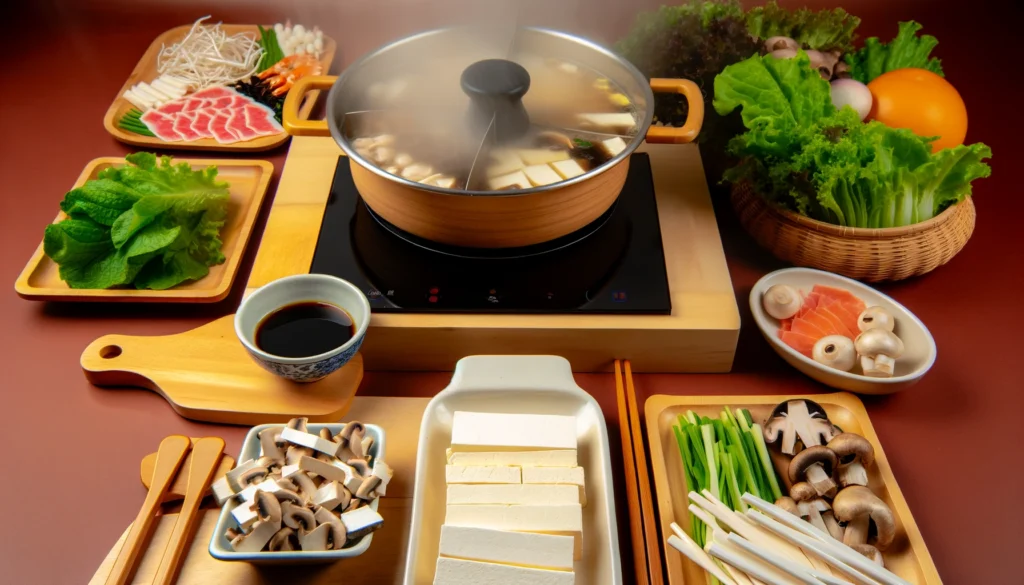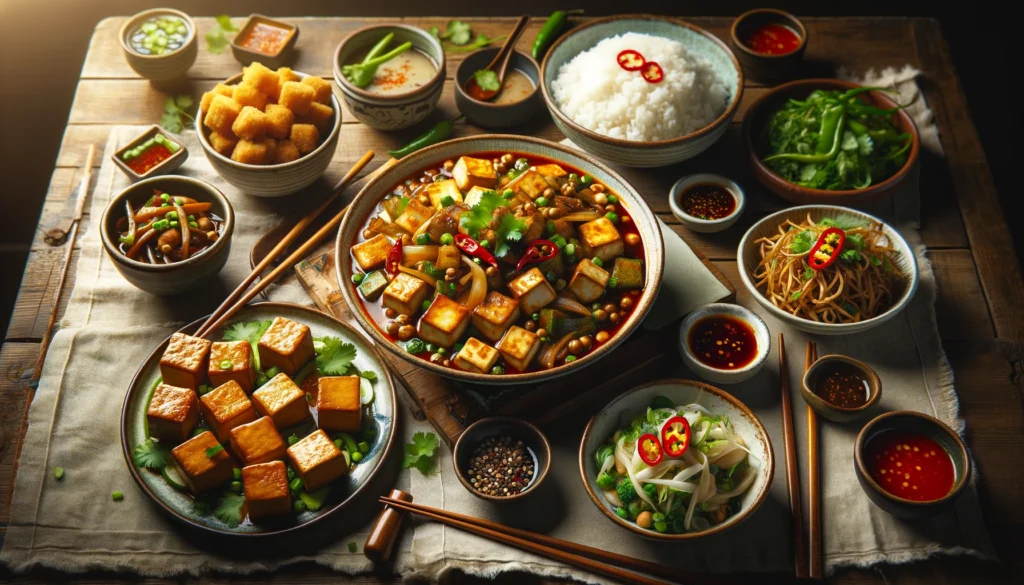The Ultimate Guide to Bean Curd: Exploring Different Types, Cooking Tips, and Delicious Recipes.
1. Introduction to Bean Curd:
Brief History and Origins of Bean Curd:
Tofu, also known as bean curd, has a history dating back over two thousand years to ancient China, believed to have originated during the Han Dynasty (206 BCE – 220 CE). According to legend, it was invented by Prince Liu An while experimenting with soybeans. Although the exact origin is unclear, tofu was a staple in the Chinese diet by the Song Dynasty (960–1279 CE) and spread to neighbouring regions like Korea and Japan, reaching Western countries in the 20th century with the rise of vegetarianism and global trade.
Importance of Bean Curd in Different Cuisines:
Bean curd’s widespread appeal lies in its adaptability and neutral taste, allowing it to easily complement the flavours and techniques of various cuisines. In China, tofu is a staple, frequently used in soups like mapo tofu, where the soft bean curd is simmered with chilli paste, Szechuan peppercorns, and minced meat. In Japan, tofu finds a home in miso soup or is fried into a pocket known as inari sushi. Korean cuisine employs it in stews such as sundubu-jjigae, a spicy broth that highlights its creamy, silky texture.
In Western kitchens, tofu’s acceptance has soared due to its role as a high-protein meat substitute. Vegetarians and vegans love using it in sandwiches, stir-fries, and curries. It can be blended into smoothies or desserts due to its versatility, and the growing awareness of plant-based nutrition has only bolstered its importance across multiple food cultures.
Nutritional Benefits of Bean Curd:
Beyond its culinary versatility, bean curd is a powerhouse of nutrition, making it a valued component of a balanced diet. Here’s a breakdown of its notable benefits:
-
- Protein-Rich:
Tofu is an excellent source of high-quality protein, providing all nine essential amino acids, making it a complete protein source akin to meat or eggs. - Low in Saturated Fat:
It has negligible amounts of saturated fats and is cholesterol-free, making it a heart-healthy alternative to animal proteins. - Rich in Minerals:
Tofu is naturally rich in minerals such as calcium, iron, magnesium, phosphorus, and selenium. Calcium is especially abundant in tofu made with calcium sulfate, offering a viable source for individuals avoiding dairy products. - Beneficial Isoflavones:
Soybeans contain isoflavones like genistein and daidzein, which have antioxidant properties and may contribute to improved heart health and bone density. Research is ongoing, but these compounds may offer protective effects against certain cancers and alleviate menopausal symptoms. - Gut-Friendly Probiotics:
Fermented tofu (fermented bean curd) is rich in probiotics that support digestion and contribute to a healthy gut microbiome.
- Protein-Rich:
Whether you’re seeking to diversify your diet, explore new flavours, or simply enjoy a nutritious, high-protein ingredient, bean curd has something to offer for everyone. Its rich history, global appeal, and nutritional value firmly establish it as a cornerstone of culinary exploration and healthy eating.


2. Different Types of Bean Curd:
Regular Bean Curd (Tofu): How it’s Made, Common Uses, and Types (Silken, Firm, Extra-Firm):
Regular tofu, the most common type of bean curd, starts with the soaking and grinding of soybeans to create a milky liquid known as soy milk. This soy milk is heated and then coagulated using a coagulant, often calcium sulfate or magnesium chloride. The curds are then pressed into blocks of varying firmness based on the pressure applied during pressing. The types range from silken to extra-firm:
-
- Silken Tofu:
Silken tofu has the highest moisture content and is not pressed after coagulation, leaving it delicate and custard-like in texture. Its smooth, creamy consistency makes it ideal for blending into smoothies, desserts like puddings and pies, or savoury sauces and dips. - Firm Tofu:
Firm tofu is pressed lightly and holds its shape well while still absorbing marinades. It is versatile and works beautifully in stir-fries, soups, or grilling. - Extra-Firm Tofu:
Extra-firm tofu undergoes the most pressing, resulting in a dense texture with minimal water content. It’s excellent for frying, grilling, or crumbling into tacos or breakfast scrambles due to its ability to hold together even under high heat.
- Silken Tofu:
Fermented Bean Curd: Process of Fermentation, Flavors, and Typical Dishes:
Fermented bean curd, or “Chinese cheese,” is made by curing tofu in brine or rice sherry with various seasonings, including chilli, rice, and salt. During fermentation, the proteins break down into amino acids, imparting a strong, savoury flavour and creamy texture to the tofu cubes. The result is a pungent condiment often used in small quantities due to its intense flavour.
-
- Flavours:
Fermented tofu can range from salty to mildly sweet, with spicy variations often incorporating chilli or five-spice powder. Some types are fermented with red yeast rice, giving the cubes a striking red hue. - Typical Dishes:
It’s a popular addition to Chinese congee as a savoury topping. It can also be mashed and used in dipping sauces, stir-fries, or braised dishes like hot pots.
- Flavours:
Fried Bean Curd: Cooking Techniques, Achieving Perfect Crispiness, and Serving Suggestions:
Fried tofu is a favourite for adding crunchy texture to meals. Here’s how to achieve that golden-brown, crispy exterior:
-
- Press the Tofu: Remove excess moisture by pressing firm or extra-firm tofu between paper towels or in a tofu press for 15-20 minutes.
- Coat with Cornstarch: Toss the tofu in a light layer of cornstarch or flour to enhance the crunch.
- Fry: Heat oil to 350°F (175°C) in a deep fryer or pan. Fry the tofu cubes until golden brown, about 3-4 minutes.
- Serving Suggestions:
Crispy fried tofu can be served as an appetizer with dipping sauces or tossed into stir-fries with vegetables. It’s also perfect for topping salads or pairing with rice and noodles.
Bean Curd Skin (Yuba): How it’s Made, Popular Recipes, and Culinary Tips:
Bean curd skin, or yuba, forms naturally on the surface of heated soy milk. It’s carefully skimmed off, folded, and dried into thin sheets or sticks.
-
- Popular Recipes:
Yuba is commonly rehydrated by soaking in warm water before being used as a meat substitute in vegetarian stir-fries. It can also be rolled around fillings to make spring rolls or braised in soy sauce and spices. - Culinary Tips:
- Soak yuba sticks in warm water for about 30 minutes to soften them before cooking.
- Use dried sheets to wrap fillings or cut them into strips to mimic noodles.
- Braise with mushrooms and vegetables for a hearty, savoury dish that absorbs the flavours well.
- Popular Recipes:
These various types of bean curd showcase the diverse ways this humble ingredient can shine in different cuisines. From the neutral, delicate flavours of silken tofu to the robust umami punch of fermented bean curd, there’s something for every palate.


3. Recipe Ideas for Bean Curd:
Szechuan Style Bean Curd:
Szechuan-style bean curd, known as mapo tofu, is a bold and flavorful Chinese dish originating from the Szechuan region. It’s known for its fiery combination of spices and the distinctive numbing sensation of Szechuan peppercorns. Here’s a guide to preparing it:
Ingredients:
-
- 1 block (14 ounces) of firm tofu, cubed
- 4 ounces ground pork or beef
- 2 tablespoons Szechuan peppercorns
- 2 tablespoons chilli bean paste (doubanjiang)
- 1 tablespoon fermented black beans
- 2 cloves garlic, minced
- 1 tablespoon ginger, minced
- 1 tablespoon soy sauce
- 1 tablespoon of cornstarch blended with 2 tablespoons of water.
- 1/2 cup chicken broth
- 2 scallions, chopped for garnish
- Cooking oil
Instructions:
-
- Prepare Tofu:
Blanch tofu cubes in salted boiling water for 2 minutes. Drain and set aside. - Toast Szechuan Peppercorns:
Dry toast the Szechuan peppercorns in a hot pan until fragrant. Grind them using a mortar and pestle. - Stir-Fry Aromatics:
Heat oil in a pan over medium-high heat. Add minced garlic, ginger, and fermented black beans. Stir-fry until fragrant. - Add Meat:
Add ground meat and cook until browned. - Make the Sauce:
In the pan, add chilli bean paste and soy sauce, mixing thoroughly. Add the chicken broth and allow the mixture to simmer. - Mix and Thicken:
Carefully add the blanched tofu, stirring gently to coat it. Blend in the cornstarch mixture to thicken the sauce. - Finish and Serve:
Sprinkle the crushed Szechuan peppercorns over the tofu. Garnish with chopped scallions. Serve hot over steamed rice.
- Prepare Tofu:
Fermented Bean Curd Recipe:
Fermented bean curd has a distinct flavour that can elevate dishes with its creamy, tangy, and savoury profile. Here’s how to incorporate it into congee or dipping sauces:
Congee Topping:
-
- Mash one cube of fermented bean curd with a fork until smooth.
- Mix in a few drops of sesame oil for extra aroma.
- Stir this paste into a bowl of warm congee (rice porridge) for a savoury breakfast or snack.
Dipping Sauce:
-
- Mash 2 cubes of fermented bean curd with a fork.
- Add 1 teaspoon of sugar, 1 teaspoon of soy sauce, and 1 tablespoon of rice vinegar.
- Thin the mixture with 1 tablespoon of warm water until smooth.
- Add chopped scallions and a pinch of chilli flakes.
- Serve as a dipping sauce for dumplings, fried tofu, or vegetables.
Fried Bean Curd:
Fried tofu can be made into various appetizers, stir-fries, or braised dishes. Here are some ideas:
Stir-Fried:
-
- Press and cube firm tofu, then coat with cornstarch.
- Deep-fry the cubes in hot oil until golden and crispy. Drain on paper towels.
- Stir-fry with your choice of vegetables, like broccoli or bell peppers, in a hot wok.
- Add soy sauce, oyster sauce, or hoisin sauce for flavour.
Braised:
-
- Cut the fried tofu into rectangular pieces or cubes.
- In a pot, sauté garlic and ginger until aromatic, then pour in soy sauce, cooking sherry , and a pinch of sugar.
- Place the tofu cubes in the pot and let them simmer until fully coated and heated through.
- Serve with steamed rice and top with chopped scallions for garnish.
Appetizer:
-
- Cut extra-firm tofu into bite-sized cubes.
- Deep-fry the cubes until crispy.
- Serve them hot with a dipping sauce like sweet chilli, peanut, or soy ginger.
With these recipe ideas, bean curd can be elevated to a whole new level of deliciousness, offering creative flavours and textures suitable for different occasions and tastes.
Explore additional plant-based eating tips with our detailed guide on 10 Essential Vegan Food Tips Every Beginner Will Love, perfect for newcomers to the vegan lifestyle.


4. Health and Lifestyle Benefits:
Exploring the Nutritional Benefits of Including Tofu in Your Diet:
Tofu is renowned for its impressive nutritional profile, making it a great addition to a balanced diet. Here’s a closer look at the key nutrients it offers:
-
- Protein:
Tofu is an excellent source of plant-based protein, offering 8 grams per 3.5-ounce (100-gram) serving. Since it’s a complete protein containing all nine essential amino acids, it rivals animal-based proteins like meat and eggs. - Minerals:
Tofu is naturally rich in minerals such as calcium, magnesium, phosphorus, and iron. A single serving provides about 20% of the daily recommended intake for calcium and is particularly valuable for those who avoid dairy. It’s also a good source of copper, zinc, and manganese, which support metabolic functions and bone health. - Isoflavones:
Isoflavones are phytoestrogens found in soybeans and tofu, particularly genistein and daidzein. These compounds mimic estrogen in the body, potentially offering health benefits like reducing menopausal symptoms, supporting bone density, and possibly lowering the risk of certain cancers. Studies suggest isoflavones can help reduce LDL cholesterol levels, contributing to heart health. - Low in Saturated Fats and Cholesterol-Free:
Tofu is naturally low in saturated fats and free of cholesterol, making it heart-healthy. It provides beneficial unsaturated fats like omega-3 and omega-6 fatty acids. - Probiotics (Fermented Tofu):
Fermented tofu, such as fermented bean curd, contains beneficial probiotics that aid digestion by promoting a healthy gut microbiome.
- Protein:
How Bean Curd Can Be a Versatile Ingredient for Vegetarian and Vegan Diets:
Tofu is a culinary chameleon that seamlessly adapts to diverse flavours and preparations. This versatility makes it a staple for vegetarians and vegans seeking a varied, balanced diet:
-
- Texture Flexibility:
From the custard-like consistency of silken tofu to the dense, meaty texture of extra-firm tofu, bean curd can replicate various textures. Silken tofu is ideal for dairy-free desserts like chocolate mousse or cheesecake, while firm tofu holds up well in stir-fries or grilling. - Flavor Absorption:
Tofu’s neutral taste allows it to absorb marinades, spices, and sauces easily, making it suitable for many flavour profiles. Whether it’s soaked in soy-ginger marinade for Asian-inspired dishes or seasoned with cumin and chilli powder for tacos, it adapts seamlessly. - Protein Powerhouse:
With its complete protein content, tofu helps vegetarians and vegans meet their protein needs without animal products. It can be crumbled into breakfast scrambles, sliced for salads and sandwiches, or blended into protein-rich smoothies. - Diverse Cooking Methods:
Tofu can be steamed, baked, fried, grilled, or blended. Grilling extra-firm tofu adds a smoky flavour, while baking gives it a chewy, dense texture. Blending silken tofu into sauces or dressings creates a creamy base that enhances texture. - Nutrient Supplementation:
For those on a plant-based diet, tofu provides essential nutrients like iron and calcium that can sometimes be challenging to obtain without animal products. Opting for tofu set with calcium sulfate can offer significant amounts of this mineral.
- Texture Flexibility:
Including tofu in your diet is not only a nutritional boost but also a culinary adventure. Its adaptability allows you to experiment with various cuisines and textures, making it a valuable ingredient in every kitchen. Whether you’re vegan, vegetarian, or simply health-conscious, bean curd can enrich your meals in both flavour and nutrition.


FAQs on Bean Curd and Curd Usage:
- How to use bean curd in cooking?
Bean curd (tofu) can be used in soups, stir-fries, salads, desserts, and even smoothies. Its neutral flavour allows it to absorb the seasonings and marinades it’s cooked with, making it versatile for many cuisines. - What are the different ways to cook tofu?
Tofu can be steamed, stir-fried, grilled, baked, or deep-fried. Each method offers a unique texture and flavour, providing endless possibilities for recipes. - What dish is also known as bean curd?
Mapo tofu is a famous Szechuan dish known as bean curd. It features tofu simmered in a spicy chili-bean sauce with ground meat. - How to use Bean Curd Recipe?
Bean curd (tofu) is used in a variety of vegetables, curries, and salads. It is marinated in spicy, sweet or spicy sauces and cooked in various ways. - Why is curd used in cooking?
Curd, or yoghurt, is often used in cooking to add a tangy flavour, tenderize meats, and balance the spices in dishes. It’s also a staple in marinades, sauces, and desserts. - What is bean curd good for?
Bean curd is a great source of plant-based protein, calcium, and iron. It’s low in saturated fat, making it a heart-healthy alternative to meat. - What is bean curd flavour?
Bean curd has a neutral, mild flavour that can take on the taste of any seasoning or marinade used. - How to make bean curd?
To make bean curd (tofu), soak soybeans, grind them into soy milk, and then curdle the milk using a coagulant like calcium sulfate. Press the curds into blocks and let them set. - What should not be mixed with tofu?
Avoid mixing tofu with strongly flavoured oils or sauces that overpower its mild taste. Also, some foods, like raw cruciferous vegetables, may interfere with soy absorption. - What is unhealthy in tofu?
Tofu itself is generally healthy, but processed varieties with additives, or those fried in unhealthy oils, can be less beneficial. - What to pair with tofu?
Tofu pairs well with vegetables, grains, nuts, and sauces like soy sauce or tahini. It can also be added to salads or used in marinades. - Should I boil tofu before cooking?
Boiling isn’t necessary unless the tofu has a strong bean-like flavour. Boiling also makes it firmer for stir-frying or grilling. - What is the tastiest way to make tofu?
Marinating and frying or grilling tofu can enhance its flavour and create a crispy texture, often considered one of the tastiest methods. - What is the secret to cooking tofu?
Pressing tofu to remove excess moisture helps it absorb marinades better and attain a firmer, crispier texture when cooked. - How many minutes to boil tofu?
Boiling tofu takes about 2-5 minutes, depending on the texture you desire. - How to eat tasty curd?
Add fruits, honey, or nuts to curd (yoghurt) for a sweet treat, or mix it with herbs and spices for savoury dips. - Who invented curd?
Curd’s exact origins are unclear, but it’s believed to have been made accidentally by nomadic cultures thousands of years ago due to milk fermentation. - Can we heat curd while cooking?
Curd should be heated gently or at a low temperature to avoid curdling or separating. It’s often added toward the end of cooking. - What does Ayurveda say about curd?
Ayurveda recommends consuming curd in moderation and preferably during the day. It’s considered beneficial for digestion but should be avoided at night. - Can we eat ghee and curd together?
According to Ayurveda, ghee and curd should not be eaten together as it may cause digestive discomfort. - Why does Ayurveda say no to curd?
Ayurveda suggests avoiding curd for those with specific conditions like cold or congestion because it’s believed to increase mucus. - Can we mix jaggery in curd?
Mixing jaggery with curd is considered beneficial and is a popular combination in Ayurveda for aiding digestion. - Is curd sattvic?
Curd is considered sattvic in Ayurveda when consumed fresh. Old or sour curd is believed to increase tamasic qualities. - Can diabetics eat curd?
Yes, diabetics can eat plain curd in moderation, as it has a low glycemic index and may help regulate blood sugar levels.

































